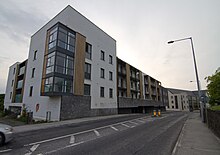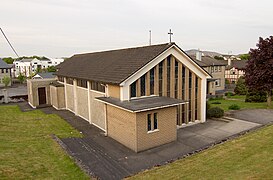Ballysadare
History
Toponymy
The Ox Mountains (Irish: Sliabh Gamh) are located west of the town. The town itself is named after the falls on the Owenmore River. Ballysadare is in the barony of Leyny formerly the túath of Luighne Connacht, and the barony of Tirerril, formerly the túath of Tír Olloíl. The Owenmore river forms the border between the baronies. Ballysadare also borders two other baronies in County Sligo, Carbury to the North and Tireragh to the West. Ballysadare is in the diocese of Achonry.
Alternative names for the falls are Eas Mac Modairn (Falls of the son of Modarn) and Eas na nÉan (The Falls of the Bird).
There appear to be three variants of English version of the settlement name still in use, Ballysadare being on the road signs coming to dominate. The use of Ballisodare remains in evidence on the names of some local sport clubs and even on at least one Sligo County Council document in 2018. Ballysodare appears to been used for the railway station and there is evidence of its use on a map of 1887 and indexing of parish registers at the National Library of Ireland.
Early history
Ballysadare is a possible location for the town noted as Nagnata on Claudius Ptolemy's 2nd century CE co-ordinate map of the world. Ballysadare was anciently a major gathering place for all surrounding districts.
St. Columba visited Ballysadare in 575 AD at which "Before the Saint (Columba) returned to Britain he founded one church in the district of Carbury, and proceeded from thence to a place called Easdara, where all the prelates of the neighbouring regions, and vast numbers of holy men and women had come to meet him ; and, to say nothing of the rest of the multitude, which was almost beyond counting, a great many distinguished saints of the race of Cumne are recorded to have been present." This extract is from Colgans Acta Sanctorum Hiberniae.
The O'Hara were the lords of Lúighne.
Saint Féichín
St Féichín was born in the townland of Billa in the parish of Ballysadare. He is said to have studied under St. Nath Í of Achonry further to the south in the same territory. The word Bile means a sacred tree or grove. The townland is the location of the Leaba St. Féichín or St. Feichins bed. The town developed near a church founded by St. Féichín, some time before he died in 664 AD (O’Rorke 1878, 1–4).This monastic site is in Kilboglashy townland and the remains consist of a stone church known as the Great Temple of St. Féichín (Teampal mór Féichín), with a later Romanesque style carved doorway, two small buildings and a graveyard. The O'Duillenain, were erenachs of Ballysadare.
The Canons Regular of St. Augustine built a new priory a short distance to the west in Abbeytown Townland in the 13th century. Ballysadare was mentioned in the Annals of the Four Masters 15 times between 1158 and 1602, in 1188, 1199, 1228, 1230, 1235, 1239, 1249, 1261, 1267, 1285, 1360, 1444, 1595 and 1602. In 1360, the Annals of the Four Masters note: A bridge of lime and stone was built by Cathal O’Conor across the river of Eas-dara. In 1588, all monastery lands around Ballysadare were seized by the Dublin Castle government on behalf of the Crown.
Mines
Ballysadare is the site of an ancient silver and lead mine, re-opened and worked in the 19th and 20th century. It is now the site of a quarry.
Recent history

Ballysadare was the location of a Pollexfen Mills, since demolished. There is also a hydro electric power station in the vicinity.
The area experienced rapid development during the 'Celtic Tiger' boom, with the population almost trebling in the period between the 1996 and 2022 census (from 612 to 1,747 people). During this period several new housing estates were developed, several of which subsequently remained empty, creating ghost estates. The town was bypassed by the N4 Sligo-Collooney dual-carriageway, completed in January 1998. The N59 Ballina-Sligo road still winds through the town.
Education
It is home to St. Mary's College,a secondary school which serves the southern and western environs of County Sligo, including the surrounding areas of Collooney and Coolaney. There is also St. John's primary school which serves the surrounding area.
Transport
Ballysodare railway station was located on the Dublin-Sligo railway line but it is now demolished; it was also served by the Sligo, Leitrim and Northern Counties Railway from Manorhamilton and the route from Tubbercurry.
Gallery
-
Ballysadare Bay
-
Holy Trinity Parish Church, Church of Ireland
-
New development in the town
-
Ballysadare Roman Catholic church
-
Ballysadare river
-
St. Mary's College - A catholic voluntary co-educational secondary school
-
Older shop in Ballysadare
-
Street view of Ballysadare
See also
References
- ^ "Interactive Data Visualisations: Towns: Ballysadare". Census 2022. Central Statistics Office. Retrieved 30 September 2023.
- ^ McLoughlin, John. "Trees and woodland names in Irish placenames" Archived 25 July 2019 at the Wayback Machine. Irish Forestry, Vol. 73 (2016). p.249
- ^ Mills, David. A Dictionary of British Place-Names. Oxford University Press, 2011. p.38
- ^ "Baile Easa Dara/Ballysadare". Placenames Database of Ireland. Archived from the original on 23 February 2018. Retrieved 16 August 2024.
- ^ "Major Roadworks N59". www.sligococo.ie. Archived from the original on 24 May 2019. Retrieved 30 May 2019.
- ^ "About Ballisodare Fishing Club - Ballisodare River - Salmon River - Salmon Fishing". www.ballisodarefishingclub.ie. Archived from the original on 14 November 2017. Retrieved 30 May 2019.
- ^ "Sligo Bundoran Ballyshannon Lough Gill Ballysodare Bay Drumcliff Bay, 1887 map". alamy. Archived from the original on 30 May 2019.
- ^ "Catholic Parish Registers at the NLI". National Library of Ireland. Ballysodare and Kilvarnet. Archived from the original on 8 September 2017. Retrieved 29 May 2019.
- ^ "Ptolemy's map of Ireland: a modern decoding". Irish Geography. 41: 49–69. doi:10.1080/00750770801909375.
- ^ Coyle, John B. (John Baptist) (30 May 2019). "The life of Saint Fechin of Fore, the Apostle of Connemara". Dublin : M. H. Gill. Archived from the original on 17 October 2015. Retrieved 30 May 2019 – via Internet Archive.
- ^ Mount, Charles. "Where was the original location of the town of Ballysadare, Co. Sligo? - Dr. Charles Mount". Archived from the original on 15 November 2017. Retrieved 30 May 2019.
- ^ "Ballisodare (Ireland) Census Town". City Population. Archived from the original on 9 October 2020. Retrieved 11 March 2020.
- ^ "Irish 'ghost estates': 75% drop in unfinished housing since 2010". 16 December 2015. Archived from the original on 24 April 2017. Retrieved 26 July 2019.
Further reading
- O'Rorke, Terrence (1878). History, antiquities, and present state of the parishes of Ballysadare and Kilvarnet, in the county of Sligo; with notices of the O'Haras, the Coopers, the Percivals, and other local families. Dublin, London: J. Duffy and sons. OCLC 1045989729.








